
Learning to create real food substitutes for Optavia Fuelings was one way that helped me speed up my weight loss and develop a diet similar to Optavia. Creating DIY Optavia Fuelings from scratch doesn’t mean store-bought meal replacement bars or shakes; instead, it entails using whole foods such as vegetables, fruits, dairy, and lean proteins from the grocery store to align with the calorie and macronutrient profiles of Optavia fuelings.
To create homemade Optavia Fuelings, you must cook in advance, make snacks that are under 100 calories, use 2-3 ingredients for each snack, and include proteins with every snack. This is my general answer, but for detailed instructions on each of the 8 steps to create DIY Optavia Fuelings (listed below), along with the necessary ingredients, practical recipe tips for real food alternatives, and the benefits of following a homemade Optavia diet using real food, keep reading.
- Study Optavia Fueling ingredients
- Choose low-glycemic index foods
- Focus on the high protein foods
- Create snacks that are under 100 calories
- Cook in bulk for time-saving meal prep
- Create snacks with 2-3 ingredients
- Exclude sugars and artificial sweeteners
- Use herbs and spices for flavor without calories
1. Study Optavia Fueling ingredients
To replicate Optavia Fuelings, start by understanding the types of ingredients found. I’m not talking about stabilizers and thickeners like rice starch and guar gum, or even vitamins and minerals, so don’t worry about them. Although Optavia Fuelings are enriched with 24 vitamins and minerals, you can substitute them with a basic multivitamin such as Centrum or Nature Made. A 2008 study by Giovanni Maraini from the University of Parma found these multivitamins just as effective and bioavailable as vitamin-fortified meal replacements.
When creating your own Optavia Fuelings, focus on the nutritional facts, including the amounts of protein, carbs, fiber, and fats in each Fueling. My top protein sources include eggs, tuna fish, chicken breast, seafood, and protein powder. We eat a lot of seafood in our home, which means we have a lot of leftovers. When we buy prawns in bulk, I measure 3 oz servings and separate them into small plastic bags, often with different vegetables. Here’s a photo of my favorite DIY snack made from prawns and green peppers.
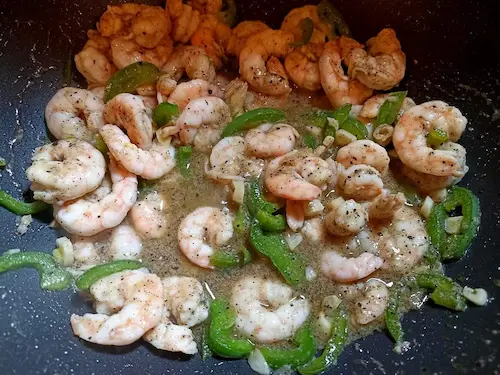
It has 3 oz of prawns, which have 76.5 calories, and one medium green pepper, which has around 24 calories. In terms of carbohydrates, I often choose low-glycemic fruits and veggies.
2. Choose low-glycemic index foods
Choosing low-GI foods such as broccoli, cauliflower rice, and cucumber for homemade Optavia Fuelings is the easiest way because they have relatively low calories and provide sustained energy release, keeping you full longer. Sure, you can replicate Optavia Fuelings with high GI foods such as pumpkins or white rice, but these have more calories per serving and when matched with Optavia Fueling caloires, won’t keep you full for too long.
Chicken and rice have been my go-to low-GI Optavia fueling alternative for a while. This one is very easy to make. You can opt for cauliflower rice, which contains only 25 calories per cup (107 grams), compared to the 210 calories found in a cup of traditional rice. Here’s a photo of my typical chicken and rice DIY Fueling.
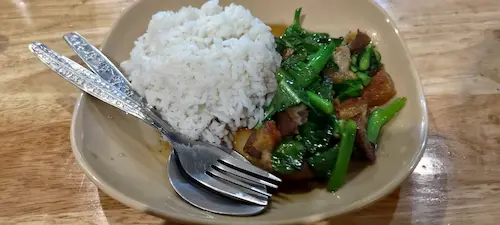
The one in the picture includes 1 cup of cauliflower rice, which contains 25 calories, and 1 oz of chicken, totaling 40 calories, along with some veggies. The entire serving comes to around 80 calories. It’s worth noting that I don’t prepare this snack individually. Instead of dedicating time to each snack, I prefer to cook my Fuelings in bulk.
You can also use fruits with a low glycemic index (GI), such as cherries, apples, and pears, which have been shown to help stabilize blood sugar levels, as demonstrated in a 2019 study conducted by Mohammad Ishraq Zafar and colleagues and published in the American Journal of Clinical Nutrition. Therefore, when creating my DIY Optavia fueling substitutes, I prioritize using low-GI foods in addition to high-protein options.
3. Focus on the high protein foods
To create your DIY Optavia Fuelings at home, prioritize proteins. Each Optavia Fueling has approximately 10 to 15 grams of protein, which is equivalent to 3.5 ounces (100 grams) of non-fat Greek yogurt or 4 ounces (113 grams) of low-fat cottage cheese.
In most of my homemade Fuelings, I double this protein amount. Having more protein keeps me feeling full for longer, so I don’t mind occasionally exceeding the calorie limit to ensure I have an adequate serving. Here’s a photo of a homemade high-protein substitute for Optavia’s breakfast meal that slightly exceeds the calorie per serving – toast with salmon and egg.
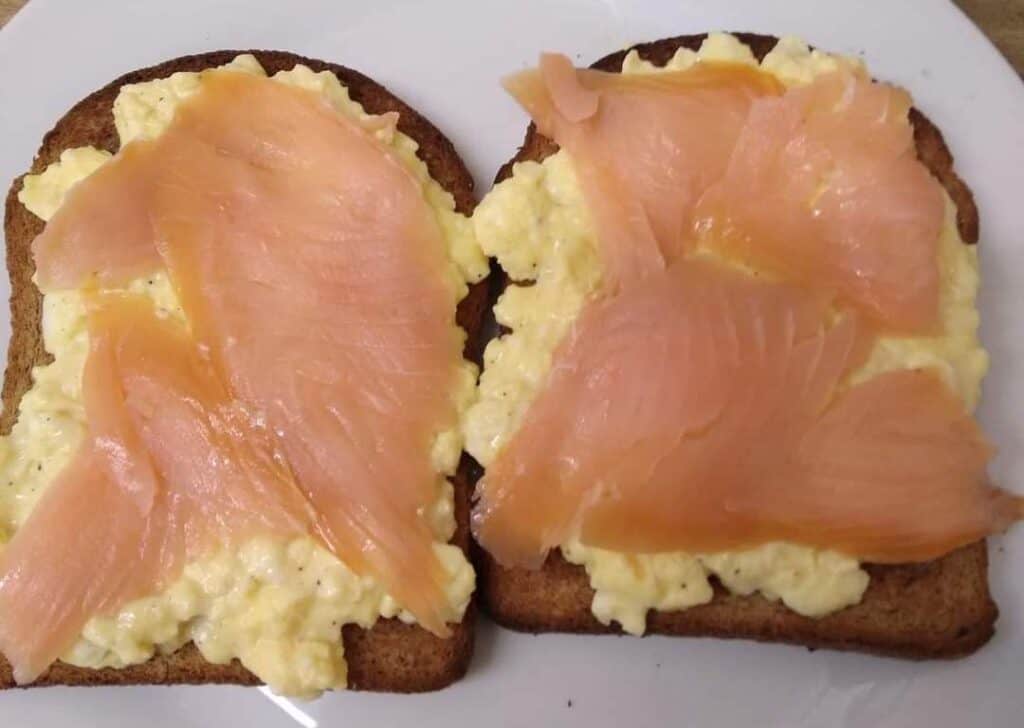
Here you have 1 oz of smoked salmon, totaling 33 calories, along with 1 large egg containing 71 calories. Pair these with two slices of SmartBread from WiO (26 calories per slice), for a light and tasty meal with just over 150 calories. If you’re concerned about calories, you can always exchange egg for cream cheese or remove one slice of bread. Here’s a photo of another high-protein DIY Optavia fueling – scrambled egg and tuna.
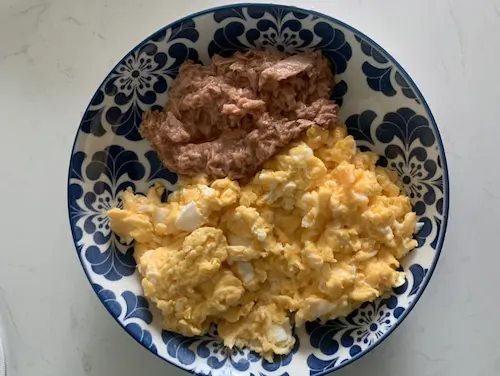
This one has 1 large egg, which has around 71 calories, and 1 small can of tuna, which has 63 calories. A total of 30 grams of proteins and 130 calories. Although I like to eat tuna a couple of times per week, I try to stay away from canned tuna, mainly because of the high mercury concentrations.
According to a 2019 study by Yasuhiko Murata from the University of California, Santa Cruz, published in the Environmental Toxicology and Chemistry Journal, eating more than 3 cans of tuna per week can potentially exceed the US Environmental Protection Agency’s reference dose for methylmercury of 0.1 µg per kilogram of body weight per day. Even when my DIY Fuelings portion size goes beyond 100 calories, I prefer this over getting hungry again soon.
4. Create snacks that are under 100 calories
To replicate Optavia fuelings, aim for snacks with about 100 calories each. This approach allows you to closely mimic Optavia’s products without buying them. For accuracy, use calorie-counting apps like MyFitnessPal, YAZIO, or Nutritionix, and a food scale to measure portions. Here’s what 100-calorie snacks look like.
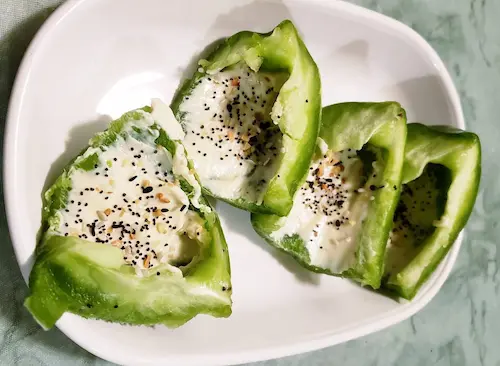
On this plate, you have 1 sweet pepper, 2 tablespoons of cream cheese, and 1 tablespoon of chia seeds. All food items combined have less than 100 calories. Notice the plates we use are not bigger than 7 inches. (I realized that I eat less if I serve my meals on smaller plates.)
5. Cook in bulk for time-saving meal prep
“Cooking in bulk in advance means I can do Optavia meal prep for the entire week, rather than scrambling to put together a meal each day. On Optavia 5 and 1, you need to have five Fuelings and one lean and green, so unless you’re working from home, making five fuelings from scratch each day is not practical. That’s where batch cooking comes in.
The easiest approach for me is to choose one type of Optavia Fueling and prepare five portions of it. It’s both easy and efficient. In my opinion, this is an excellent way to stick to a long-term DIY Optavia diet, allowing you to control portions and monitor ingredients ahead of time. However, if you have more time, you can certainly make five different Optavia Fuelings. Here’s the photo of what my meal prep looks like.
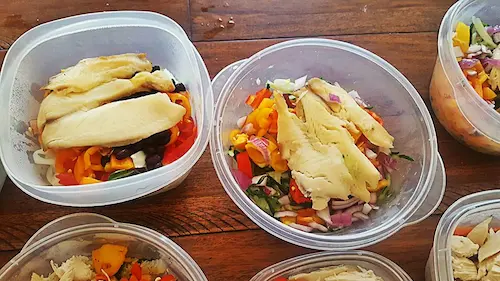
Here you have Ancho Tilapia prepared for the 5 days in advance for me and my wife. Although we eat this dish for our main meal, any leftovers are used for Fuelings and snacks.
6. Create snacks with 2-3 ingredients
If you’re trying to recreate the Optavia fuelings experience at home, there is no shortage of fresh ideas available to you. However, to keep things simple, I pare down my routine and focus on snacks with a maximum of 2 or 3 ingredients (not including condiments like salt or pepper).
For example, you can make an egg white and spinach mini omelet with 3 egg whites and a cup of spinach. Alternatively, combine 1/2 cup of non-fat Greek yogurt with 5 chopped almonds. You can also try Tuna and Cucumber Bites using 2 ounces of canned tuna on half a sliced cucumber. Each snack is a simple mix of 2 or 3 ingredients, perfect for a quick protein boost. While it may not seem like much, this kind of simplicity has revolutionized my cooking routine. Plus, it’s quicker and cheaper than the more complicated culinary experiments I used to do.
In my view, making a protein shake is one of the simplest methods to whip up Optavia-friendly snacks using just 2-3 ingredients right in your kitchen. One scoop of protein shake has around 70 calories. Plus, you can always make your DIY Optavia shake taste better by adding coffee. Here’s a photo of my wife, Emiliia, drinking her favorite vanilla protein shake at our local coffee shop in Coral Gabels.
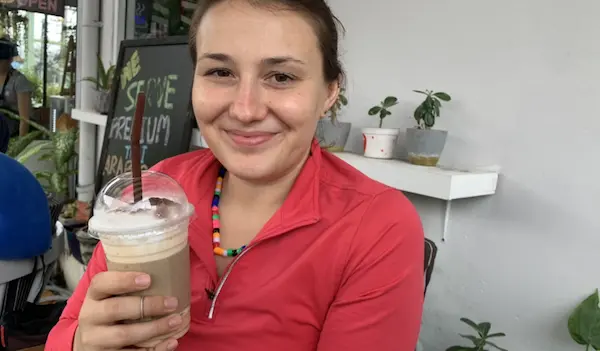
She has lactose intolerance and this place offers coffee protein shakes with plant-based protein powders. Optavia has many shakes and drinks, so it’s always a good idea to find similar shakes or make your own from scratch. Another great way to DIY your Optavia shakes is by blending your favorite fruits with protein powder. Here’s a photo of two different types of fruit smoothies, both made with plenty of ice.
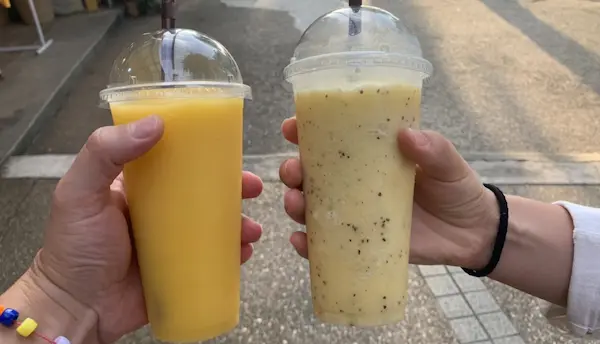
On the left, you have a mango frappe with 1 cup of mango, containing 50 calories, and protein powder adding 70 calories, totaling 120 calories and 28 grams of protein. On the right, there’s a banana and passion fruit frappe, with just over 200 calories. For fruit smoothies, we avoid flavored protein shakes. I prefer unflavored protein powder, like Isopure Unflavored Whey Isolate, to avoid a weird aftertaste from sweeteners and to enjoy the natural sweetness of real fruit.
7. Exclude sugars and artificial sweeteners
As much as I like sweet snacks, I limit my sugar content to a minimum. For my smoothies, coffee, and other shakes, I don’t add any extra sugar. Instead, I add low-calorie fruits and vegetables that have naturally sweet flavors, like berries and carrots. Although Optavia doesn’t allow me to eat fruits, I like to include different types of berries in my homemade fuelings. Here’s how I buy berries from my local market.
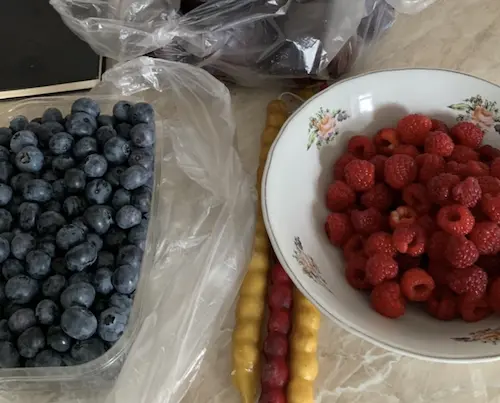
I prefer purchasing larger 0.5-pound containers, especially during the season, and opt for frozen berries in winter. For a quick Optavia homemade fueling, try 1/2 cup of raw blueberries (43 calories) paired with a handful of almonds (10 pieces, around 70 calories), totaling 115 calories. Alternatively, you can opt for more natural sweeteners allowed on Optavia, such as stevia and erythritol. This not only helps me stay within healthier dietary guidelines, but it also helps me avoid sugar crashes. It’s a fairly easy switch that can make a huge difference.
8. Use herbs and spices for flavor without calories
I’ve started using herbs and spices in my DIY Optavia cooking, and it’s been a game-changer for adding flavor without the extra calories. For instance, sprinkling some cinnamon on my oatmeal or adding fresh basil to my Optavia salads gives them a burst of flavor without any guilt. Experimenting with different combinations, like rosemary on grilled chicken or cumin in my vegetable stir-fries, has made my Optavia real food Fuelings much more enjoyable and diverse, all while keeping my calorie intake in check.
What are some easy recipes for DIY Optavia Fueling?
The following list outlines 9 recipes for DIY Optavia Fueling ideas to help you discover healthy and affordable snacks that you’ll love.
- Sushi
- Seaweed Salad
- Fried Pork
- Papaya Salad
- Noodle Soup with Chicken
- Chicken and Broccoli
- Salmon with Egg
- Beef Salad
- Beef Shashlik
1. Sushi
I’ve been a sushi lover for many years, and there are many reasons why I love it. For me, eating sushi is an experience – from the perfectly arranged pieces of sushi to the flavors, it’s always a pleasure to enjoy this dish. What’s more, it can be a great weight loss aid as most pieces of sushi come in around 100 calories or less. Here’s a photo of my favorite Philadelphia roll (9 pieces) that I share with my wife.
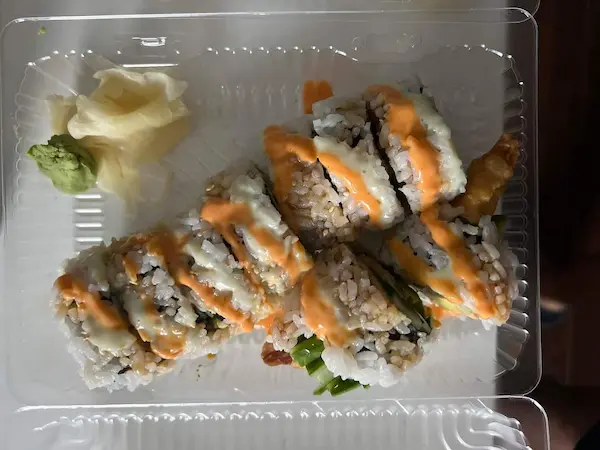
This one is made with salmon, cream cheese, dill, sesame seeds, pretzel salt, cucumber, and ginger slices. One piece of Philadelphia roll has around 30 calories. I don’t make sushi at home. (Maybe one day I will learn.) I also don’t order big boxes.
According to the U.S. Food and Drug Administration (FDA), “sushi and other raw seafood items should be used within 2 days after purchase”. For my DIY Optavia diet, I get about 10 pieces of Optavia-approved sushi options from my local sushi restaurant (or shop) and keep them organized in my fridge for a maximum of one day. If I go out, I ensure I follow my Optavia dining out guide checklist which has over 16 useful tips on how to stay fuller for longer.
2. Seaweed Salad
You can include seaweed salad as a DIY Optavia snack. Personally, it’s one of my favorite homemade Fuelings. According to a 2021 study by Silvia Lomartire from the University of Coimbra, published in the Marine Drugs Journal, “seaweeds are rich in several bioactive compounds that not only protect the seaweeds but also offer high nutritional value and several benefits for humans.
I usually do batch cooking and store the cooked seaweed in the fridge. Here’s a photo of the leftover salad I used for my fueling alternative. (It tastes better than it looks.)
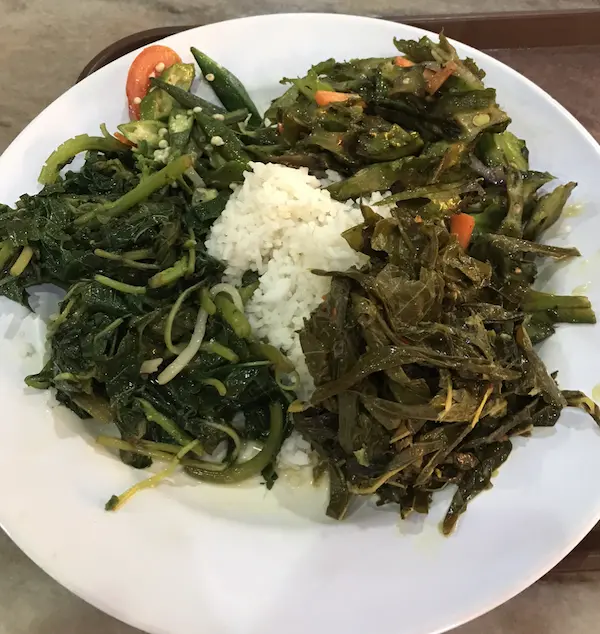
I often add chicken or turkey slices, already prepared during my meal prep ritual. This one is low in calories (around 100 calories or less).
3. Fried pork
You can include fried pork in your DIY Optavia-style diet, but be mindful of portion sizes. While I don’t often consume pork belly, I take advantage of discounts at my local butcher when available. I fry and portion it into 1 oz servings, which contain approximately 147 calories each.
Sometimes, I pair it with veggies, but on certain days, I enjoy it as a solo snack. Pork tends to keep me feeling full and satisfied for longer compared to other meats. And, despite its slightly higher calorie content, a small 1 oz serving often curbs my hunger, and there are times when I don’t even consume all 5 Fuelings in a day. Here’s a photo of my 3 oz fried pork belly. (Nothing fancy.)
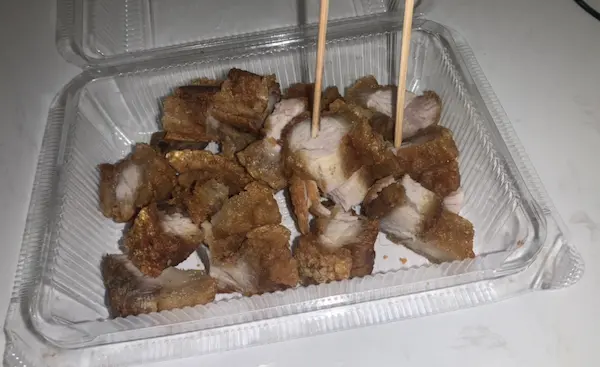
4. Papaya salad
I have always been a fan of papaya salad because it’s bursting with flavor and can easily be adapted to suit different tastes. Although I’m not the biggest fan of Southeast Asian cuisine, the papaya salad has stolen my heart. And, to be honest, I’m not the best cook for this dish (I prefer to buy it from my local market.) Here’s the photo of my favorite papaya salad.

This salad has slices of chicken with unripe papaya, ground peanuts, tomatoes, garlic, chilies, and fresh lime juice. Not sure about calories, but it’s very tasty and filling.
5. Noodle soup with chicken
When creating your own Optavia-inspired meals, you can include Noodle soup with chicken. I recall consuming a lot of instant noodles during my university days, though now, not so much. On the 5 and 1 plan, wheat pasta isn’t permitted, but there are plenty of Optavia-approved low-calorie noodles available, made from hearts of palm or organic Konnyaku flour. While we do have a few packets of Palmini noodles in our pantry, they’re usually our last resort or for those days when I feel too lazy to cook anything else. Here’s the photo of hearts of palm pasta soup with chicken and coriander.
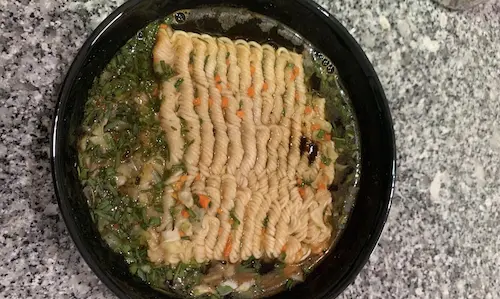
This one has 1 packet of noodles, which has around 47 calories, and 1 oz of chicken with 67 calories.
6. Chicken and broccoli
When it comes to making Optavia with real food, chicken and broccoli are my go-to daily meal choices. (Though my wife isn’t as keen on it.) This dish is irresistible to me – the combination of juicy, savory chicken and flavorful broccoli, seasoned just right, never fails to delight. On shopping days, I take time to wash, peel, and chop all the vegetables, storing them in separate bags or plastic containers. I do the same with the meat. This prep makes it super convenient to just grab what I need from the fridge, especially when I’m in a hurry. Plus, a serving of chicken and broccoli contains just over 100 calories, allowing me to enjoy this meal guilt-free every day. Here’s a snapshot of my chicken and broccoli fueling.
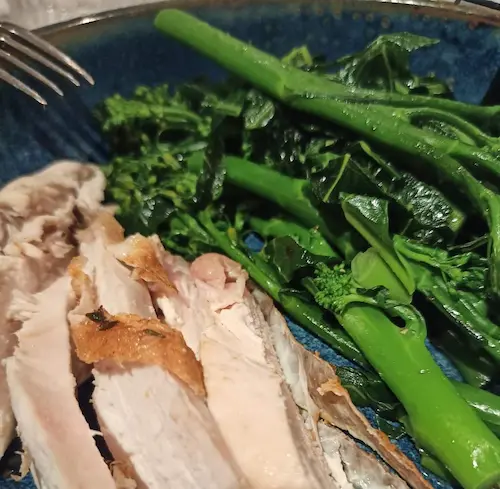
7. Beef salad
I have always been a huge fan of beef salad. Whether I’m serving it as a main course for dinner or as an Optavia fueling alternative, this delicious dish is always appreciated. Although beef is quite easy and quick to cook, I always prepare it in batches. Here’s a photo of my beef salad. (Yes, it’s made from leftovers.)
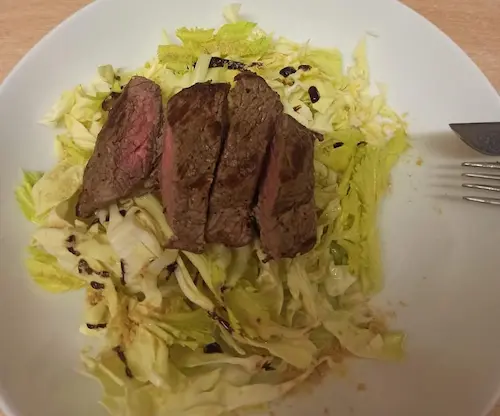
This one has 2 oz of beef, which has around 90 calories (19), and a handful of lettuce. I like the combination of spices and other vegetables like green beans, peppers, or broccoli. (Nothing wrong with snacking on cooked beef by itself as well.)
8. Beef shashlik
On the days when I cook more beef, I also like to make a beef shashlik. Nothing fancy. Just slices of beef skewed on the wooden sticks (but trust me, with the right spices it tastes delicious). First, I measure and weigh 3 oz beef portions. Then I skew them on these little chopsticks and put them on my grill. Here’s what it looks like.
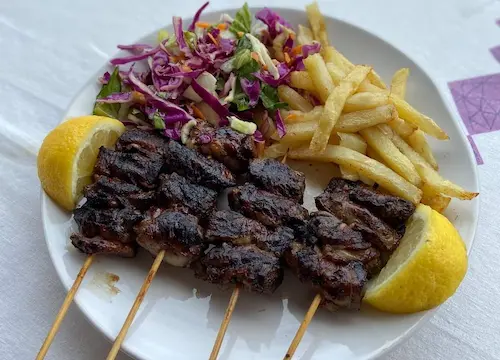
Here I served them with a side salad and a portion of french fries. However, you can always adjust the sides based on your preferences. Once skew has 3 oz of beef, which is around 135 calories. Sure, it’s more than the recommended 110 calories, but for me, it’s worth it.
What are the benefits of making DIY Optavia Fuelings?
Making DIY Optavia Fuelings offers several benefits.
- Cost-Effective: By preparing my own Optavia fuelings, I’ve been able to continue the program without the high costs. I used to spend about $500 per month on Optavia products, but now I make similar meals at a fraction of the price.
- Nutritional Control: Creating my versions of Optavia meals allows me to control the nutritional content. I ensure they match the original’s nutritional value but with less reliance on processed ingredients.
- Customization for Dietary Needs: Eating 5 small snacks throughout the day significantly helped with my energy levels and eased my digestion problems. According to a 2019 study by Franca Marangoni from the Nutrition Foundation of Italy published in the International Journal of Food Sciences and Nutrition, “the inclusion of 1–2 snacks in the daily pattern alleviates the potential digestive and metabolic overload caused by fewer heavier meals.”
- Personalized Ingredients: DIY Fuelings give me the freedom to avoid certain ingredients like soy and gluten, and instead, I can include foods I enjoy and tolerate well, such as fruits, dairy, and nuts.
- Variety and Enjoyment: Making my own Optavia Fuelings has added variety to my diet. I experiment with different ingredients and flavors, which keeps my meals interesting and enjoyable.
What ingredients should I use for homemade Optavia meals?
For homemade Optavia diet meals, stick to protein powders, lean meats like chicken or fish, and low-carb veggies like broccoli or spinach.
Are there any online resources for Optavia-like meal planning?
Yes, check out the EatProteins.com website, which provides guides and lists specifically for Optavia-like meal planning.
How do I calculate the macros for homemade Optavia meals?
To calculate macros for homemade Optavia meals, use calorie-counting apps or online calculators to track protein, carbs, and fat.
Can I substitute Optavia snacks with homemade versions?
Yes, you can substitute Optavia snacks with homemade versions; just aim to keep them around 50 calories, similar to the calorie content of Optavia snacks.

What bread are you using that only has 28 calories a slice?
Hey Holly. This one was SmartBread from WiO (a bit pricey, though), but we also buy white/whole grain from Extraordinary Bites. I hope that helps!
So it sounds like the idea is to replace fuelings with “meals” that are around 100 cal with 10-15g of protein? We’re not big on fish but maybe I can make some of these work. I need more on the go foods because of my very busy lifestyle.
Hi, Jennifer. Yes, you’re right, 100 kcal and 10-15 grams of protein would be ideal. For more ready to eat ideas, check out our Optavia Fueling Substitutes guide. I hope that helps
Hi Michael,
Love your blogs about optavia fueling
Can you give me some ideas of a fueling for breakfast?
Hi there,
Thank you só much!
By the way can I make a fueling with miracle noodle and 3 oz of shrimp?
Hey Mari, my top choices would be protein smoothies with fruits, scrambled eggs with tuna, and cottage cheese with nuts.